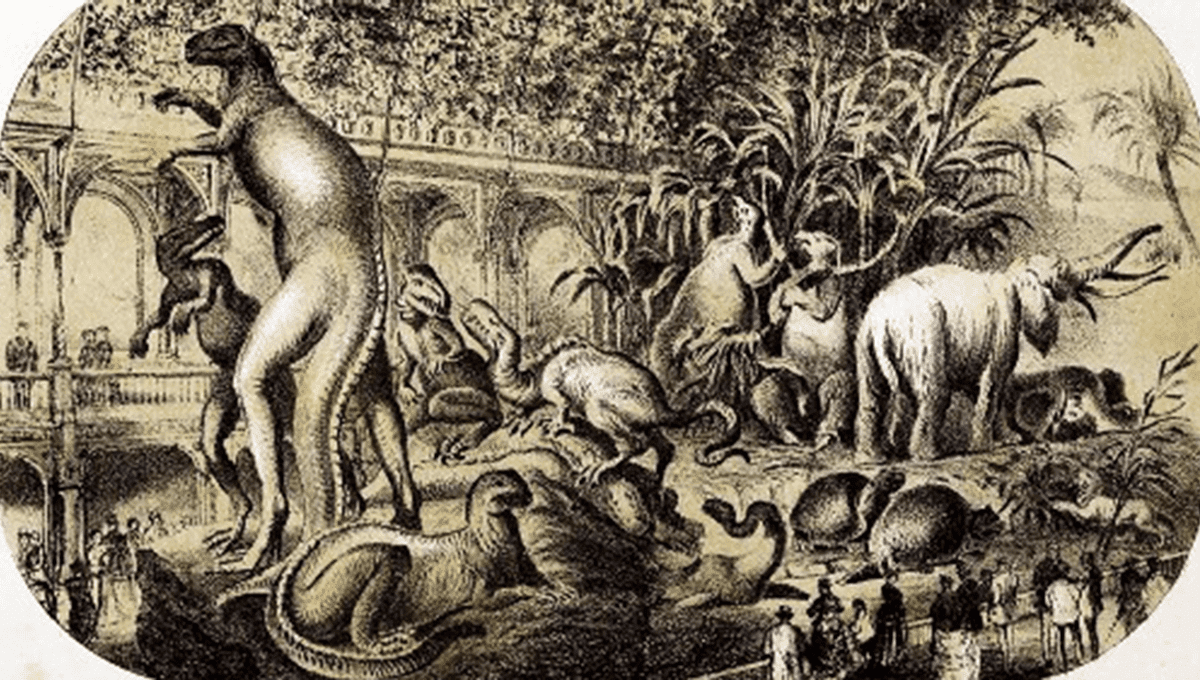
In May 1871, a gang of “toughs” set about smashing an unusual target: a collection of model dinosaurs destined to be part of a new museum in Central Park, New York. The gang smashed the models with sledgehammers, then carted away the pieces – and any designs or molds to make more were destroyed. Someone wanted those displays gone, but until now we may have been focusing on the wrong person, a new study concludes.
The models had been created by Benjamin Waterhouse Hawkins, responsible for an impressive display in Crystal Palace, London, some ten years prior. Hawkins had been hired by New York City to create a display in Central Park, but in 1870 that project was canceled by corrupt politician William “Boss” Tweet after taking command of the city.
Many of the dinosaur models were complete, and would surely have been used for display elsewhere. However, later the next year, a gang smashed the dinosaurs to pieces.
“Previous accounts of the incident had always reported that this was done under the personal instruction of ‘Boss’ Tweed himself,” study co-author Professor Michael Benton of Bristol’s School of Earth Sciences said in a press release, “for various motives from raging that the display would be blasphemous, to vengeance for a perceived criticism of him in a New York Times report of the project’s cancellation.”
“Reading these reports, something didn’t look right,” co-author Victoria Coules added. “At the time Tweed was fighting for his political life, already accused of corruption and financial wrong-doings, so why was he so involved in a museum project?”
The team noted in their study that Tweed was constantly being attacked in the newspapers at the time, making revenge for a critique on page five of the newspaper unlikely.
“So we went back to the original sources and found that it wasn’t Tweed – and the motive was not blasphemy or hurt vanity.”
The team places the likely suspect as “strange character” Henry Hilton, the Treasurer and VP of Central Park and a man who already had a reputation for strange acts of vandalism. Hilton ordered that a bronze statue in Central Park be painted white by the sculptor. When the sculptor refused, he ordered for it to be removed and painted white anyway. The team found, through looking at the minutes of meetings, that Hilton pushed against compensating Hawkins for his work after it had been canceled, not Tweedy.
“The primary sources of the day show that Henry Hilton (1824–1899) was responsible not only for engineering the destruction of Hawkins’ studio and models through his political manoeuvring, but that he also sent in the thugs,” the team write in their study.
“Although it could still be argued that Tweed was guiding everything from behind the scenes, we have not found any evidence of this, and we propose to show that Hilton was entirely capable of acting in a headstrong and ill-advised manner under full public scrutiny, as borne out by the many huge errors and controversies he triggered through the rest of his life.”
Later in life, Hilton duped a widow out of her husband’s fortune by persuading her to hand over all of her inherited business interests to him. For this he paid $1 million: a sum he had received from the late husband to execute his will, closing various businesses and giving the proceeds to his wife and family.
Looking at contemporary reports, the team found that Hawkins blamed Hilton at the time, claiming that he had done so “out of ignorance, just as he had a coat of white paint put on the skeleton of a whale… and just as he had a bronze statue painted white”. The report claimed that Hilton had previously told Hawkins that he “should not bother with ‘dead animals’, that there was plenty to do among the living”.
“This might seem like a local act of thuggery but correcting the record is hugely important in our understanding of the history of palaeontology,” Professor Benton added. “We show it wasn’t blasphemy, or an act of petty vengeance by William Tweed, but the act of a very strange individual who made equally bizarre decisions about how artefacts should be treated – painting statues or whale skeletons white and destroying the museum models. He can be seen as the villain of the piece but as character, Hilton remains an enigmatic mystery.”
The study is published in the Proceedings of the Geologists’ Association.
Source Link: New Suspect In The Mysterious 1871 Destruction Of New York's Paleozoic Museum